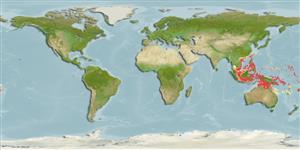>
Gobiiformes (Gobies) >
Gobiidae (Gobies) > Gobiinae
Etymology: Trimma: Greek, trimma, -atos = something crushed (Ref. 45335); xanthochrum: Name from the Greek ‘xanthos' meaning yellow or golden, and ‘chros’ for colour of the skin, or body surface, referring to the yellow colouration of the body and caudal fin..
More on author: Winterbottom.
Environment: milieu / climate zone / depth range / distribution range
Écologie
marin démersal; profondeur 12 - 70 m (Ref. 87358). Tropical
Western Pacific Ocean: Indonesia.
Taille / Poids / Âge
Maturity: Lm ? range ? - ? cm
Max length : 2.5 cm SL mâle / non sexé; (Ref. 87358)
Description synthétique
Morphologie | Morphométrie
Épines dorsales (Total): 7; Rayons mous dorsaux (Total): 7-8; Épines anales 1; Rayons mous anaux: 8. This species is characterized by the following: a wide interorbital region (80-100% pupil diameter); the second dorsal spine usually reaching posteriorly to between the bases of the second to third dorsal fin rays; pectoral rays 15-16, usually with 7-8 branched rays; vertical rows of sensory papillae below eye of 2-3 papillae in rows 1-4 and 4-5 in row 5; caudal blotch which has a lower half about two-thirds the width of the upper half; usually an overall yellowish body with yellow at least proximally in the caudal fin (Ref. 87358).
Inhabits current-prone reefs in 12-70 m (Ref. 90102).
Life cycle and mating behavior
Maturité | Reproduction | Frai | Œufs | Fécondité | Larves
Winterbottom, R., 2011. Six new species of the genus Trimma (Percomorpha; Gobiidae) from the Raja Ampat Islands, Indonesia, with notes on cephalic sensory papillae nomenclature. aqua, Int. J. Ichthyol. 17(3):127-162. (Ref. 87358)
Statut dans la liste rouge de l'IUCN (Ref. 130435)
Menace pour l'homme
Harmless
Utilisations par l'homme
Plus d'informations
PaysZones FAOÉcosystèmesOccurrencesIntroductionsStocksÉcologieRégime alimentaireÉléments du régime alimentaireConsommation alimentaireRation
Noms communsSynonymesMétabolismePrédateursÉcotoxicologieReproductionMaturitéFraiRassemblement de ponteFéconditéŒufsDéveloppement de l'œuf
Taille/ÂgeCroissanceLongueur-poidsLongueur-longueurFréquences de longueursMorphométrieMorphologieLarvesDynamique des populations larvairesRecrutementAbondanceBRUVS
RéférencesAquacultureProfil d'aquacultureSouchesGénétiqueElectrophoresesHéritabilitéPathologiesTraitementNutrientsMass conversion
CollaborateursImagesStamps, Coins Misc.SonsCiguateraVitesseType de nageSurface branchialeOtolithesCerveauxVision
Outils
Articles particuliers
Télécharger en XML
Sources Internet
Estimates based on models
Preferred temperature (Ref.
123201): 26.7 - 28.9, mean 27.9 °C (based on 194 cells).
Phylogenetic diversity index (Ref.
82804): PD
50 = 0.5000 [Uniqueness, from 0.5 = low to 2.0 = high].
Bayesian length-weight: a=0.01023 (0.00477 - 0.02194), b=3.02 (2.84 - 3.20), in cm total length, based on LWR estimates for this (Sub)family-body shape (Ref.
93245).
Fishing Vulnerability (Ref.
59153): Low vulnerability (10 of 100).
